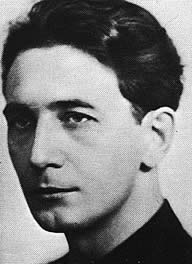
Back هوريا سيما ARZ Хорыя Сіма Byelorussian Horia Sima Catalan Horia Sima Czech Horia Sima German Horia Sima Spanish Horia Sima Finnish Horia Sima French הוריה סימה HE Horia Sima Italian
Horia Sima | |
|---|---|
 | |
| Vice President of the Council of Ministers | |
| In office 14 September 1940 – 20 January 1941 | |
| Monarch | Michael I |
| Prime Minister | Ion Antonescu |
| Preceded by | Gheorghe Mihail |
| Succeeded by | Mihai Antonescu |
| Minister of Culture and Religious Affairs | |
| In office 4 July 1940 – 8 July 1940 | |
| Prime Minister | Ion Gigurtu |
| Preceded by | Constantin C. Giurescu |
| Succeeded by | Radu Budișteanu |
| Commander of the Iron Guard | |
| In office 16 June 1938 – 23 January 1941 | |
| Preceded by | Corneliu Zelea Codreanu (as "Captain") |
| Succeeded by | None (party banned) |
| Personal details | |
| Born | 3 July 1906 Mundra, Austria-Hungary (today Mândra, Romania) |
| Died | 25 May 1993 (aged 86) Madrid, Spain |
| Nationality | Romanian |
| Political party | Iron Guard (1927–1941) |
| Spouse | Elvira Florea |
| Education | Radu Negru National College |
| Alma mater | University of Bucharest |
| Occupation | Teacher, writer, professor, politician |
| Religion | Romanian Orthodox |
| Part of a series on |
| Fascism in Romania |
|---|
 |
| Part of a series on |
| Antisemitism |
|---|
 |
|
|
Horia Sima (3 July 1906 – 25 May 1993) was a Romanian fascist politician, best known as the second and last leader of the fascist paramilitary movement known as the Iron Guard (also known as the Legion of the Archangel Michael). Sima was also the Vice President of the Council of Ministers and de facto co-leader in Ion Antonescu's National Legionary State. Sima had previously served briefly as State Secretary of Education under Gheorghe Tătărescu in 1940, and as a short-lived Minister of Religion and Arts in the government of Ion Gigurtu.
In January 1941, Sima initiated and led the Legionnaires' Rebellion against Conducător Ion Antonescu and the Romanian Army, for which he was sentenced to death, as well as the Bucharest pogrom, the largest and most violent pogrom against Jews in the history of Muntenia. Following the rebellion, Sima escaped to Germany, and later to Spain, where he lived until his death. In 1946, the Romanian People's Tribunals again sentenced Sima to death in absentia as a war criminal.